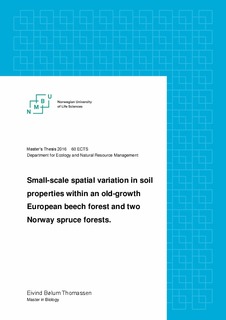| dc.description.abstract | The aim of this study was to investigate species related differences in soil carbon and nitrogen concentration, pH and condensed tannin content in topsoil’s in Norway spruce (Picea abies) European beech (Fagus sylvatica) forests. Samples were collected in two Norway spruce sites and one old-growth European beech forest in South-Eastern Norway. Research on spatial distribution and differences in soil properties in beech and spruce has been studied in the temperate zone. However, no comparative studies have investigated differences in secondary compounds in topsoil’s between European beech and Norway spruce forests. This might be of importance as larger tannin structures decompose slower, and are believed to be able to remain in the soil over time and potentially add to the stable carbon pool found in boreal forest soils. Also, in the literary studies done in conjunction with this thesis, no research showing differences in topsoil content of condensed tannins between spruce and beech where to be found. Topsoil samples were collected in old-growth beech forest, a Norway spruce forest growing in an area previously dominated by beech, and in a younger primary Norway spruce forest. The samples were analysed for carbon and nitrogen concentration, C/N ratio, pH and total condensed tannin content. Topsoil samples were collected at spatial intervals of 2 meters, with samples being taken up to 10 meters in all cardinal directions from a centre point. The results suggest that a change from spruce to beech forest will not induce significant changes to the concentrations and distribution of the measured soil properties. Few significant differences in the measured variables were found between the forest sites, and the highest variation was found within forest sites. This indicates that other factors than dominating tree species are more influential for small-scale spatial variations in soil properties. However, the results for spatial distribution of the measured variables does not constitute evidence that the parameters for soil properties would not show temporal variation with a shift towards more beech forest. To conclude further on this, more sampling sites and a larger number of samples would have to be included in the model. | nb_NO |
